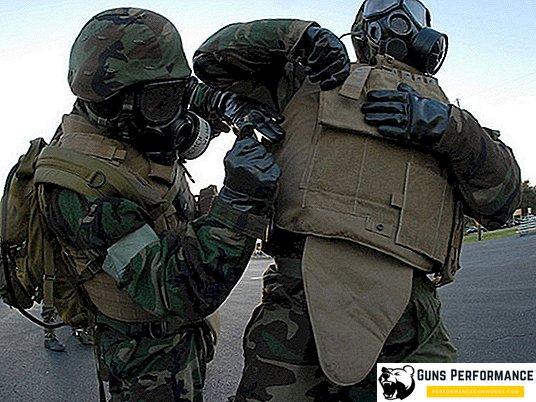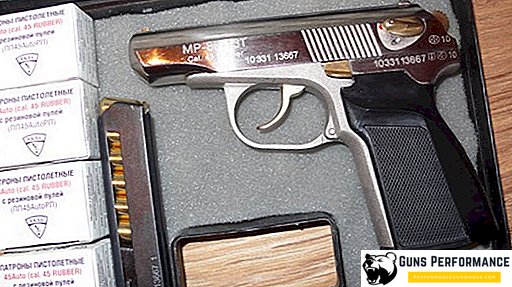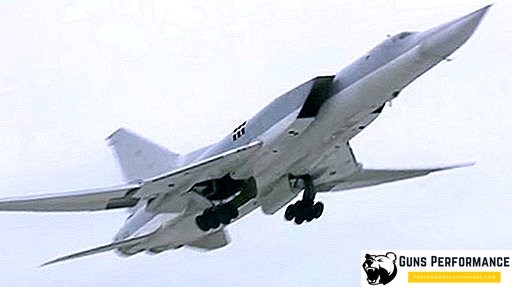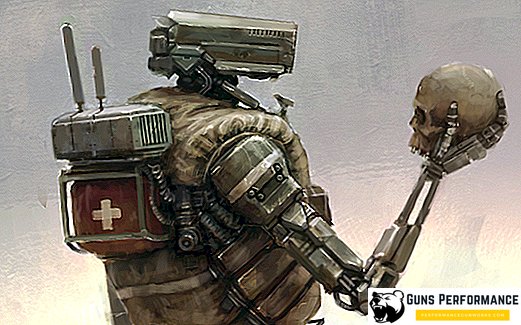
The Kirov heavy nuclear missile cruiser (TARK) is the lead ship of the project 1114 Orlan, which was built from 1973 to 1989 at the Baltic Shipyard in Leningrad. Today, there is only one Orlan in the ranks - the Peter the Great TARK. In total, four heavy cruisers of project 1114 were built. Another ship of this series, the Admiral Nakhimov, is currently being modernized.
To date, the heavy cruiser Peter the Great is the largest non-flying military ship in the world. According to the NATO classification, it is referred to as a battlecruiser, that is, a “battle cruiser”. It should be noted that the project 1114 cruisers were the first (and only) surface ships of the Soviet fleet with a nuclear power plant (NPP). At present, Peter the Great is the only surface ship with nuclear power plants that is currently in service with the Russian Navy.

History of the creation of the cruiser project 1114 "Kirov"
In the early 60s, the main task of the surface ships of the USSR Navy was considered to be the fight against enemy submarines; therefore, it consisted of only four small missile cruisers, but the construction of new destroyers and anti-submarine ships was active.
Naval leaders realized the need to create strike ships capable of performing anti-ship functions. One of the attempts to rectify the situation was the armament of the BOD project 1134 with P-35 anti-ship missiles, which made it possible to retrain them in missile cruisers.
Also, as part of the Soviet Navy, there were no surface ships with a nuclear power plant. The military has long wanted to put the "peaceful atom" in the service in the surface fleet: the first work in this direction was carried out back in the 50s. At that time, several draft designs of the new cruiser with nuclear power plants were prepared, but because of the great complexity and cost, they were rejected.
However, after the Caribbean crisis, it became obvious that the fleet needed ocean-going ships with a long range, capable of conducting patrols in the farthest corners of the oceans for a long time.
In 1961, the first nuclear-powered cruiser of the Long Beach BWI became part of the American fleet. Perhaps this event was the impetus for the start of work on the creation of the Soviet heavy nuclear missile cruiser.
Since at this time the destruction of enemy submarines was considered a priority, the new ship with nuclear power plants was originally conceived as BOD. It was planned that he will replace the old anti-submarine ships and will be released in a large series. However, the question immediately arose about the support ships of the new BOD, which had practically no means of air defense and was very vulnerable to enemy aircraft.
At the end of the 60s, a nuclear cruiser project appeared, equipped with a powerful air defense system and missile anti-ship weapons.

In the early stages of development, it was planned to create two ships: the BOD and the missile cruiser, which would operate in pairs, covering each other from threats from under the water and from the water, providing a powerful echelon air defense system.
Then the idea emerged to combine the projects of these two ships, however this required the installation of a new sonar complex on a promising cruiser, for which it was necessary not only to significantly increase its displacement, but also to increase the power of the power plant.
In 1971, the final draft of a new heavy nuclear missile cruiser, which received the designation of 1114, appeared. By the way, this classification was assigned to the lead ship already during construction, it was laid down as an "atomic anti-submarine cruiser".
The development of the ship involved in the Leningrad North Design Bureau, supervised the work of B. I. Kupensky.
From the very beginning, the new nuclear cruiser was considered to be the favorite child of Admiral Gorshkov, commander-in-chief of the Soviet fleet, however, despite this, work on it was difficult and slow. Gorshkov required that in addition to a nuclear reactor, the new ship also had an organic fuel power plant. At that time, the nuclear power industry in the fleet was still a novelty; there was not enough experience in operating nuclear facilities in the Soviet Union (and abroad), and there were constant accidents with reactors.

In 1973, the construction of the lead ship of the project 1114 began at the Baltic Shipyard in Leningrad, it was named the Kirov. It was launched at the end of 1977, three years later, "Kirov" was introduced to the Soviet Navy.
"Kirov" had really impressive power: its main anti-ship weapons were twenty Granit missiles, capable of hitting the enemy at distances of 625 km. Anti-aircraft defense of the ship was provided by air defense systems "Fort" (marine modification S-300) and Osa-M. The cruiser was equipped with a powerful anti-submarine defense system, torpedo tubes, artillery systems. "Kirov" was one of the first warships in the world, which were placed vertical launchers for rocket armament. This not only saved space, but also simplified the launch and maintenance of anti-ship and anti-aircraft missiles.
Project 1114 ships were equipped with the latest Polynom hydroacoustic complex, as well as the most advanced types of radar equipment.
In the period from 1980 to 1988, three ships of the Project 1114 entered the Soviet fleet: the Kirov, the Frunze and the Kalinin. A fourth heavy nuclear cruiser from this series, the Yuri Andropov, was also laid. All ships after the "Kirov" were carried out on an improved project - 1114.2. They received more advanced weapons systems that were ready at the time of their construction.
"Yuri Andropov" was completed after the collapse of the USSR and adopted by the Russian fleet under the name "Peter the Great". Of all four ships of the project, he is considered the most "advanced" in the number and range of weapons.
In 1984, the first long-range combat campaign of the cruiser "Kirov" in the Mediterranean Sea. In the same year, during a fire at the ammunition depot in Severodvinsk, "Kirov" was left in the harbor in order to shoot down missiles flying from the scene of the fire using air defense systems.

From about the mid-80s, long hikes of heavy nuclear cruisers began to happen less and less often due to lack of funding. In 1992, "Kirov" received a new name - now it became known as "Admiral Ushakov." However, such a "rebranding" did not change the situation for the ship for the better: all three cruisers of Project 1114 were transferred to the reserve and were in it for many years.
In 1999, the modernization of the cruiser began in Severodvinsk, but in 2002 he was withdrawn from the fleet. For many years there were disputes about what to do next with the cruiser. In August 2018, the final decision was made to dispose of the ship, and later Rosatom announced a tender for recycling. The unloading of spent nuclear fuel from the Kirov reactors will be at the expense of Italy.
In 2012, it was decided to start the modernization of the cruiser "Admiral Nakhimov". The ship will be equipped with new vertical launchers that will allow the Admiral Nakhimov to use the Onyx, Caliber and Zircon missiles. They will become the main weapon of the cruiser. In addition, the ship will be updated air defense system: it will include the S-400 air defense system and new air defense systems of short-range. It is planned that the modernization will end in 2018 or 2019.
Description of the design of the TARK project 1114 "Kirov"
The length of the hull of the heavy missile cruiser "Kirov" is more than 252 meters, the full displacement of the ship - 28,000 tons. Like other ships of the project 1114, he has a long forecastle. The well-thought form of the hull and significant displacement provide the Kirov with good seaworthiness, which is very important for any ship in the ocean zone.
The size of the cruiser is really impressive. The ship has more than 1,400 rooms for various purposes, 140 of which are reserved for cabins for midshipmen and sailors, 30 for cockpit sailors, the total length of the corridors of the ship is twenty kilometers. On board there are fifteen showers, several baths, a sauna, an excellent medical unit with an ambulatory, an insulator, an X-ray room, an operating room and a dental office. The crew has a gym, some mess-rooms, and even their own television studio. The hull of the ship is divided into sixteen compartments with the help of watertight partitions; five decks pass along the entire length of the hull.
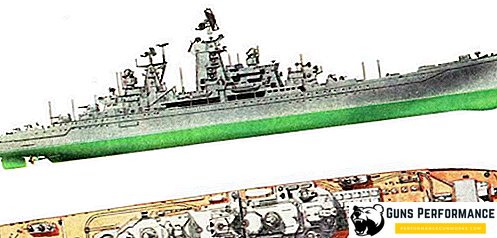
In the bow of the heavy cruiser is the antenna of the Polynom hydroacoustic complex, and at the stern is a underdeck hangar designed to accommodate three Ka-27 helicopters or its modifications Ka-29, as well as fuel supplies for them. Here is the lift, which lifts the rotary-winged cars on the upper deck.
In the stern of the ship is towed sonar antenna and devices for its ascent and descent into the water.
The heavy nuclear cruiser Kirov (like the other ships of project 1114) has developed superstructures that are made with the active use of aluminum and magnesium alloys. Most of the ship’s weapons are in its fore and aft parts.
All project 1114 cruisers are equipped with anti-torpedo protection, they have a double bottom, for the first time after World War II, these ships received a well-developed reservation. However, there is no belt armor on the cruiser - it is located deep in the hull of the ship and protects its vital parts. The only exception is the thickening of the hull along the waterline (one meter below it and two and a half meters above).
The armor was protected by the rocket cellars of the Granit complex, the engine room, the premises of the combat information post and the command post, which are located deep inside the hull. In addition, bookings were: helicopter hangar, ammunition depot and fuel for helicopters and the tiller compartment.
The cruiser "Kirov" has a power plant with atomic reactors KN-3, which are created on the basis of icebreaking reactors. However, KH-3 have significant differences. Fuel assemblies are filled with highly enriched uranium (about 70%), which makes it possible to extend the life of the core to 10-11 years.
KN-3 is a water-to-water type reactor, double-circuit, with thermal neutrons. In the first circuit, bidistillate is used as a coolant, which cools the core and transfers heat to the second circuit, and it supplies steam to the turbines. The power plant of the ship allows you to supply electricity and heat to an average-sized city, with a population of 100-150 thousand people.
The total thermal capacity of the two reactors is 342 MW. The cruiser power plant consists of four steam turbine generators (3 MW) and four gas turbine generators (1.5 MW). Kirov has two additional boilers located in the turbine section. They allow the cruiser (without using nuclear reactors) to reach speeds of up to 17 knots and travel 1300 nautical miles.
The crew of the cruiser consists of 727 people, including 97 officers.
The main armament of Project 1114 cruisers is P-700 Granit cruise missiles. They have a starting weight of seven tons, can accelerate to a speed of 2.5 M and carry a warhead weighing 750 kg or a nuclear charge of 500 Kt. The range of the rocket is 625 km. Each Project 1114 cruiser had twenty Granite missiles on board. Shooting was carried out from launchers, which were located on the upper deck of the ship. Initially, the P-700 Granit was designed to arm submarines, so before launching the launcher was filled with seawater.
P-700 "Granit" is a third-generation anti-ship missile that has a reduced profile of the approach path to the target. Because of the high speed and extremely inconvenient trajectory for the enemy, it is very difficult to knock down the RCC "Granit". A large mass of the warhead can effectively destroy even the large ships of the enemy.
The main anti-aircraft armament of the 1114 cruisers is the Fort-A-to-Air Corps, which is nothing more than a naval modification of the famous S-300 complex. The Fort’s ammunition consists of 96 missiles, the launchers are located in rotating drums below the deck. At the last of the project ships, TARK Peter the Great, a more complete modification of the complex, the Fort-M, was installed.

The second echelon of the naval air defense system is the Osa-M SAM system, which is capable of striking enemy air targets at distances of up to 15 km. Reach height is 3.5-4 km. On the Peter the Great cruiser, the Osa-M air defense missile system was replaced by a more modern short-range air defense system, the Dagger air defense missile system. The missiles of this complex are unified with the ground system "Thor-1M". The ship is equipped with eight launchers "Dagger".
The last line of anti-aircraft defense of the cruiser "Kirov" are the artillery systems AK-630, each of which has six 30-mm cannons.
The cruiser "Kirov" is equipped with two single-barrel 100-mm gun mounts AK-100. On subsequent ships of the project they were replaced with one twin 130-mm AK-130 installation.
Anti-submarine armament "Kirov" consists of PLUR "Metel", with a launcher in the nose, as well as bomb-bomb RBU-6000 and RBU-1000. Mine-torpedo armament of the ship - ten torpedo tubes of 533 mm caliber.
Evaluation of the project of heavy nuclear missile cruiser "Kirov"
To refer to many types of Soviet weapons and military equipment, the epithets “unique” or “unparalleled in the world” are often used. In many cases, this is true. However, it should be clearly understood that this was often done not from a good life - it was just that the country did not have the necessary resources to start production of products made on the basis of "standard" solutions.
Project 1114 cruisers can also be called a “unique asymmetric” response to the adversary. The leadership of the USSR for many years puzzled over what can be opposed to American aircraft carrier groups.
It was these ships, together with the submarines of Project 949 / 949A and the Tu-22M missile-carrying aircraft, that were to become the basis of the Soviet anti-aircraft forces.
The Orlan project ships carried a huge number of different types of missile weapons on board, but only the Granit anti-ship missiles were the offensive means. Everything else was good only for self-defense. However, there is great doubt about the effectiveness of the use of anti-ship missiles to destroy ships of the carrier group.
The size and cost of a single cruiser of the Orlan project were very large, and their shock functions (the ability to hit AUG) were significantly inferior to cheaper projects 949 submarines.
In the course of the modernization, which will be subjected to the Admiral Nakhimov TARK, the Granit anti-ship complex will be dismantled, and the cruiser will be equipped with universal launchers, which are suitable for firing Onyx and Caliber missiles instead. This will turn a potential "aircraft carrier killer" into a multipurpose vehicle capable of performing a wide variety of tasks.

Specifications
Below are the tactical and technical characteristics of TARK "Kirov":
The standard displacement is 24,300 tons, full displacement is 28,000 tons.
- Length - 252 m.
- Width - 28.5 m.
- Height - 59 m.
- Draft - 9.1 m.
- The power plant has 2 KN-3 nuclear reactors and 2 additional boilers.
- Power - 140 thousand hp
- Travel speed - 31 knots.
- Navigation range - unlimited at the reactor, boilers - 1300 miles.
- The crew - 727 people.
- Armament: PKR P-700 "Granit", ZRK "Fort", ZRK "Osa-M", RBU-6000, RBU-1000, 10 x 533-mm torpedo tubes, two AK-100; 3 anti-submarine helicopters Ka-27.



